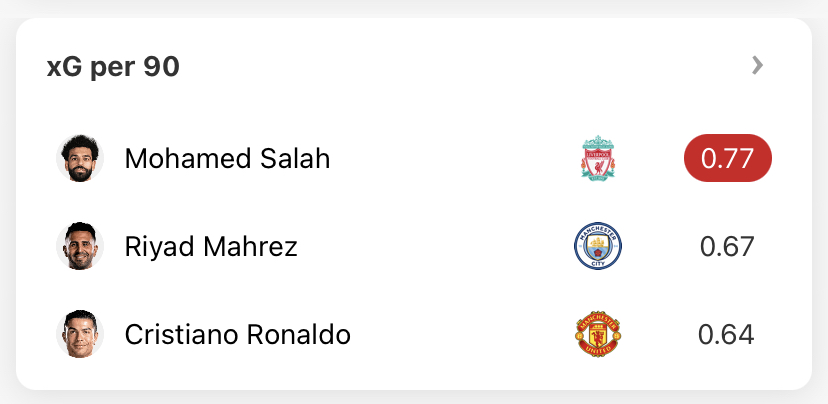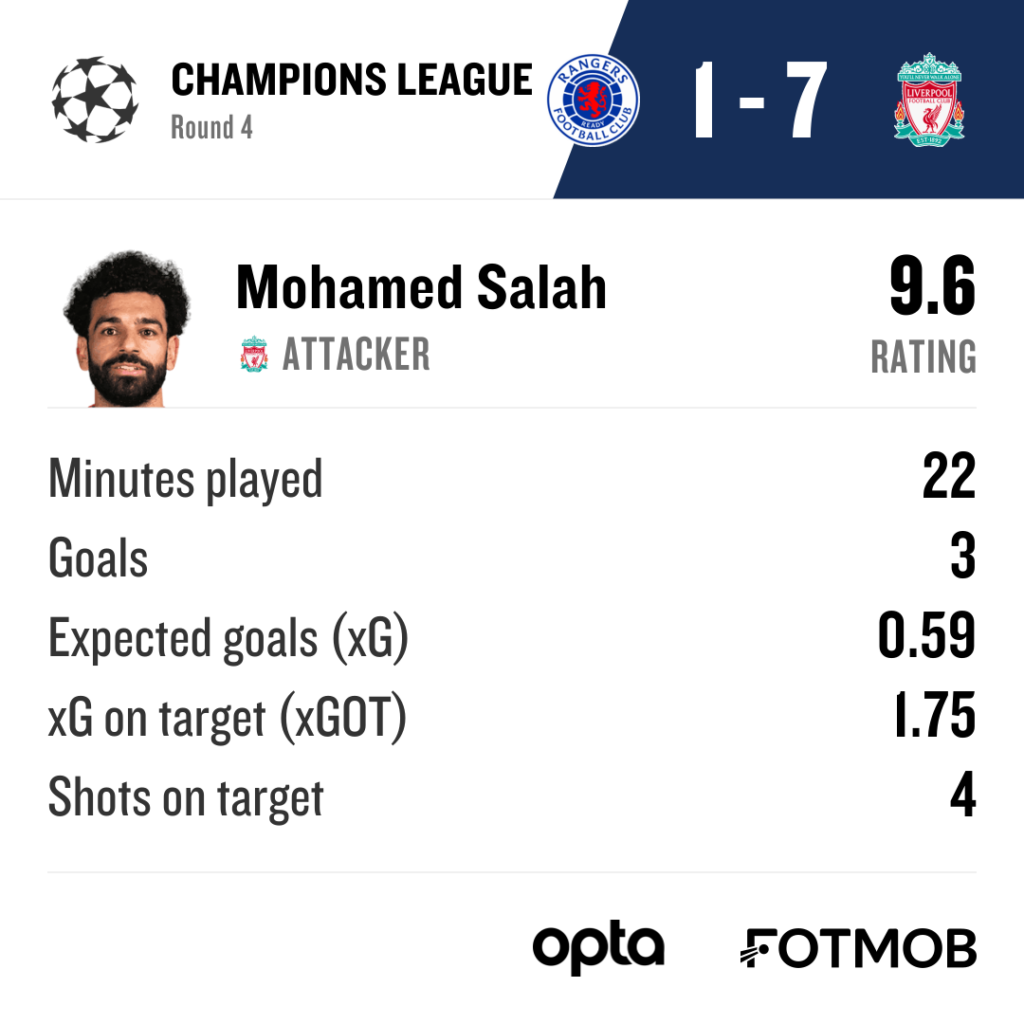In the first of a new series of special features, we take one of the most talked about tactical storylines in the Premier League season and break it all down for you.
By Sam McGuire, Premier League expert
Mohamed Salah was playing the best football of his career just 12 months ago.
He had 10 goals and five assists in ten matches across multiple competitions for Liverpool heading into the October international break, midway through the month.
This time around, however, his 13 outings have returned just eight goals and three assists. And it is worth noting that he’s scored four in his last two to boost those totals.
Heading into the game against Manchester City, his last open-play goal for the Reds in the Premier League was back in August.
Statistically speaking, Salah was more dangerous than ever during the 2021/22 campaign. Yet recently, the 30-year-old had been posting some of his worst numbers in the red of Liverpool. So what is going on?
To start, we’ll focus on what was occurring before the recent system change. His shots per 90 average had dropped from 4.5 to just three and, as a result, his Expected Goals per 90 average had almost halved from 0.77 per 90 to just 0.41. The former Roma man looked isolated and predictable.
The confusing thing is that this is all by design.
Jürgen Klopp had tweaked things this term following the arrival of Darwin Núñez. Instead of being the main goal threat for the Reds, Salah had been tasked with more of a creative role. Deployed in his usual position on the right, the Egypt international would hold the width a little more and look to isolate full-backs in one-on-one situations with space to attack before getting the ball into the penalty area.
In many ways, that had been a success. Salah, for example, ranked second for chances created (26), though just two of those are classed as big chances, and he was fourth for Expected Assists behind Kieran Trippier, Gabriel Martinelli and Kevin De Bruyne. So it has been a successful experiment if you solely focus on those numbers. But you can’t just do that, can you?
Salah is a three-time Golden Boot winner. He holds the record for most goals scored in a single Premier League campaign and he is one of the best chance-getters in the competition’s history.
He looked a shadow of his former self and it cannot be a coincidence that Liverpool find themselves in mid-table now that Salah’s goals have dried up. The prolific wide forward ranked 22nd in the Premier League for xG90. He was first for this particular metric last season.

Klopp had nullified his most potent attacker.
Against Arsenal, he had just one shot and he was replaced after 69 minutes. The Reds, without a win since August, replaced Salah with Fabinho at 2-2. That alone says a lot about the predicament that the club found themselves in.
Liverpool were forced into changing their shape with Klopp saying they needed to go back to basics. A 4-2-4 shape was used in the following matches – successfully against Rangers and unsuccessfully at the Emirates. This system gave the Merseysiders more attacking options but isolated Salah even further, as seen below.
Diogo Jota, Luis Díaz and Núñez are all in central areas as Liverpool look to progress the play while Salah holds the width on the right. Jordan Henderson picks him out with a pass and he is immediately closed down by Takehiro Tomiyasu and Martinelli. The ball goes back to the captain who clips it into the box where all of the forwards, with the exception of Salah, are waiting.
We see another similar situation above. Henderson is working the ball out to the right with Salah initially positioned in space. The other Liverpool forward are highlighted in central areas.
The No.11 is fronted up by Tomiyasu and is unable to beat the Arsenal left-back. But had he done so, Granit Xhaka was filling in at left-back meaning Gabriel, the left-sided centre-back could remain in the middle of the box with partner William Saliba.
For Salah to do anything in this phase of play, he needs to beat Tomiyasu and Xhaka before finding space in a crowded penalty area to get a shot off. It was by no means impossible for a player of his quality, but it was far more complicated than it should have been.
The Salah of yesteryear would have been making the run highlighted in the graphic. He may not have received the pass, after all it is a tricky one to execute, but his presence would’ve created space for others and Liverpool could’ve created something in the ensuing chaos. Perhaps Tomiyasu tracks the run and this frees up an area for Jota, as an example. All of a sudden the Reds have a bit of an overload on that flank.
Salah doesn’t even attempt to make that run. He just holds his position and Díaz’s floated pass eventually finds him. By this stage though, Arsenal have plenty of bodies back and it is an easy situation to defend. It was not an opportunity for Liverpool, but it was a situation that would’ve been leveraged a little better.
And then came the change.
Klopp started Salah on the bench against Rangers but came on with 22 minutes to play, replacing Núñez in one of the central positions.
He proceeded to score the fastest hat-trick in Champions League history and was praised by his manager afterwards, with the German tactician saying: “Different position, more inside. Outstanding player.”
The subtle tweak transformed, well, everything for the Liverpool No.11.
Instead of having to occupy wide areas, Salah was able to play against a centre-back. He was a threat in behind. His first was a little fortunate, with the ball falling kindly for him but it comes about because of where he’s positioned.
For his second, he is stationed between the centre-backs instead of being pinned against the touchline. Salah had four shots during his 20 minute cameo and could’ve had an assist after playing in Jota from the right. Another perk of playing centrally – he can impact the game across the final third.

Klopp stuck with Salah as a centre-forward for the match against Manchester City.
His faith was rewarded with the 30-year-old netting the winner. He caused all kinds of problems for the away side and at times he single-handedly occupied their entire back three. It was a proper No.9 performance from Liverpool’s No.11. The highlight being when he forced Ederson into the save of the match.
Salah initially dropped deep to drag Rúben Dias into the Liverpool half. He then spins the former Benfica man and attacks the acres of space behind City’s defensive line.
It was an old-school drop deep and then spin in behind move, and it worked so well. Firmino played the ball to his strike partner and Salah raced through only to be thwarted by a fingertip save by Ederson.
City could not cope with Salah. They feared him and that has been missing over recent months. The return of the fear factor can only be a positive for Liverpool.
On another day, he finishes with two goals and an assist. And this against the team with one of the best defensive records in the league. It was a statement performance.
With Jota and Díaz now both ruled out for the foreseeable future, the Reds can’t afford to isolate Salah in wide areas. He needs to be the man leading the line. If the last two outings are anything to go off, last season’s form could well return.

(Images from IMAGO)
You can follow every match from the 2022/23 Premier League season live with FotMob — featuring deep stats coverage including shot maps, xG, and player ratings. Download the free app here.
